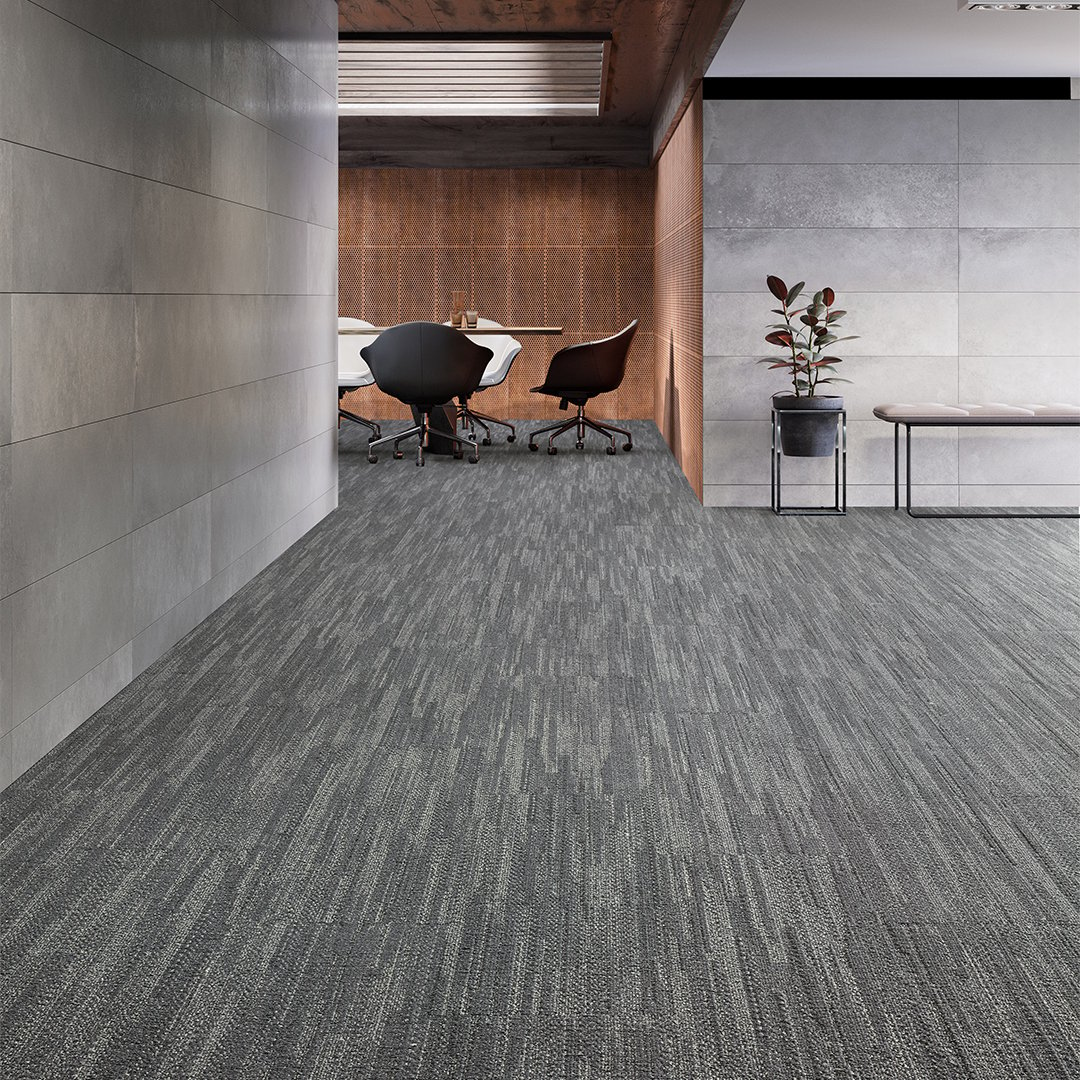Pattern, fiber and color are each important to consider when specifying carpet. But what about the carpet backing itself? The underside of carpet, or the carpet backing, is often overlooked but plays a critical role in the performance and longevity of your carpet.
At Mannington Commercial, we’ve been manufacturing flooring for more than 100 years and are committed to manufacturing the highest performing carpets possible, which means we take all parts of carpet construction into consideration when designing and manufacturing products. And that includes the backing.
In this article, we will explore what to consider when choosing a commercial carpet backing system. We’ll review the specific needs of different market segments for commercial carpet, common problems that arise with using the wrong backing system and which tests to use to be sure you are buying the right product for your specific end use.
Commercial Carpet Backing for Different Market Segments
Generally speaking, all customers want the same basic performance from carpet – a durable product that retains its appearance long-term. However, some market segments prioritize certain features over others. In some instances, the carpet backing is what is solely responsible for the performance feature. In other instances, the performance is a combination of the fiber, construction and the backing. Let’s look at some of the performance needs of different market segments.
Healthcare
Two important needs from the healthcare market segments are moisture barriers and antimicrobial treatments. Moisture barriers prevent liquids from passing through the secondary backing. When moisture passes through the secondary backing, mold can become trapped under the carpet. In addition to eliminating mold grown under the carpet, keeping moisture from penetrating the secondary backing also allows for easier cleaning and eliminates wick-back staining.
Wick-back staining is what happens after the cleaning of a spill when there is not a moisture barrier present. Without a moisture barrier, liquid is trapped in and under the secondary backing. When you clean the carpet, you are cleaning the surface of the carpet only, so the liquid can be reabsorbed by the fibers in the carpet. It is similar to oil traveling up the wick of a candle, which is where wick-back staining gets its name.
Antimicrobial treatment is also extremely important in healthcare applications. In order to be effective for healthcare, the commercial carpet must pass AATCC 174. This test assures the carpet can inhibit the growth of fungus and bacteria.
Other considerations for healthcare are resistance to stains, roller mobility, the ease of maintenance, the ability to effectively clean the carpet, the ability for the carpet to withstand heavy foot traffic and to provide comfort underfoot.
Education
Education facilities must consider a host of issues before choosing carpet. An obvious consideration is stain resistance.
Education also requires a high tuft bind to avoid surface irregularities (zippering, sprouts and edge ravel) and high density to withstand heavy foot traffic and avoid furniture indentation.
Education has a need for moisture resistance, ease of maintenance, sound absorption and comfort under foot. Additionally, education facilities almost always have budget constraints to keep in mind when selecting carpet.
Corporate
Corporate considerations include appearance retention (measured by TARR), stain resistance, the ability to withstand heavy traffic in corridors and exits, the ability to resist damage from rolling chair casters, the ability to rearrange office and systems furniture configurations and sustainability.
Governmental/Institutional
Considerations for governmental or institutional settings include products that meet architectural specifications, products that meet budget considerations, ease of maintenance, high tuft bind, stain resistance and sustainability.
Retail
Retail settings prioritize durability, stain resistance, ability to resist edge ravel (because many stores are open to other flooring), the ability to resist wear and the ability to recover from heavy traffic.
Hospitality
Hospitality considerations include stain resistance, ability to resist edge ravel, comfort underfoot, durability, ability to withstand frequent maintenance and the ability to resist wear and recover from heavy foot and rolling traffic.
Carpet Backing Tests
Whenever you have a concern about the future performance of your carpet, it is important to ask for any testing regarding that concern. Let’s look at some of the more popular testing categories.
Tuft Bind
Tuft bind is the amount of pressure (measured in pounds) that it takes to pull the tuft from the carpet. If you’re specifying this backing system for a school, you might want a higher tuft bind than if you’re specifying it for an office building. The industry test for tuft bind, both wet and dry, is ASTM D 1335.
Delamination
A delamination test will measure how many pounds of pressure is required to pull the secondary backing from the primary carpet structure. Excess moisture or water is often what causes delamination, so if you know the facility will be wet extracted once a week because of heavy traffic, you would want to see the test results to understand how securely the backing is attached. The industry test for delamination is ASTM D 3936.
Moisture Penetration
The reason you want a moisture barrier backing system is so that moisture and spills cannot penetrate and seep through the backing. Without a moisture barrier backing system, moisture can get underneath the backing layer and possibly grow mold or cause wick-back staining. There are two tests for moisture penetration: the British Spill Test and Moisture Impact Test.
The British Spill Test has a lower standard. In a nutshell, this test is pouring a liquid stain on the carpet and waiting 24 hours to see if gravity has pulled the liquid through the backing. The Moisture Impact Test pours a liquid stain on the carpet, but a metal foot tries to push the stain through the backing.
Roll Chair Test
For a corporate setting, it would be important to know if the carpet backing can help the face yarn withstand 10,000 cycles of a rolling chair caster or whether or not it will matt and/or crush.
Edge Ravel
Edge ravel is mainly a concern with broadloom backing systems. This test shows how many pounds of pressure are required to pull the yarn out in a continuous strand, basically unraveling the edge of the carpet, which occurs at the seam edges of the carpet.
Carpet yarns that become unraveled are not only unsightly but also become a tripping hazard. Many times this happens because the seam is located in an unsuitable area – like under a movable desk chair or at a location in a corridor that must withstand a lot of traffic.
Antimicrobial Protection
The antimicrobial protection test shows how well the carpet backing inhibits the growth of bacteria and fungi. This test is AATCC 174.
Problems with Choosing the Wrong Backing System
Selecting the appropriate backing system for the end use is extremely important. Problems such as delamination, subfloor/adhesive compatibility problems, moisture penetration and wick-back staining, pattern mismatch because the carpet cannot be stretched, edge ravel, pulls and snags, seams pulling apart and backing deterioration are some of the most common.
Delamination
One common cause of delamination is that the wrong backing was chosen for high traffic. Too many aggressive wet cleanings may also cause delamination in latex backings. Additionally, lack of adhesive transfer can cause delamination.
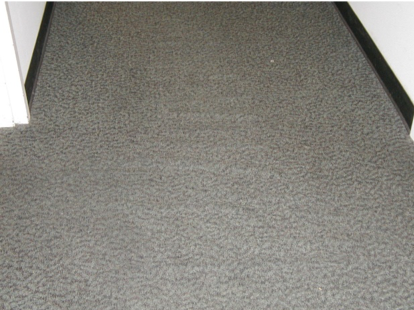
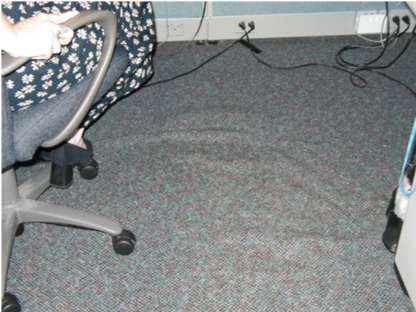
Wrinkling caused by wheel casters that delaminate carpet
Subfloor/Adhesive Compatibility Problems
It’s important that the installer test the flooring and make sure the pH tolerances are within range for the backing selected to mitigate moisture in flooring installations. It is also critical to follow the manufacturer’s instructions for the proper adhesive. Not all adhesives will work with all backings, and when the incorrect one is used, there can be unpleasant results.
For example, the adhesive may seep back up into the face of the carpet or the adhesive will release from the backing or substrate resulting in bubbles and/or wrinkles that could become a tripping hazard.
Backing Deterioration
The backing system may deteriorate because it cannot withstand excess water or there was not enough polymer used in the backing.
Edge Ravel
Traditionally a broadloom issue, edge ravel is when you can pull an entire row of tufts out of the carpet. Edge ravel may occur when there is not enough seam sealer on the seam, the backing is not suitable for the end use or the backing system has been damaged by overly aggressive cleaning or improper maintenance.
Moisture Penetration and Wick-back Staining
Wick-back staining occurs because there’s no moisture barrier and a spill soaks into the backing and then returns to the surface. Some backings allow moisture through very easily. If a spill is not cleaned thoroughly and then later liquid is reintroduced to that area, the stain can easily wick back to the surface. Be careful of the kinds of chemicals you use because they can make wick-back staining worse. Especially if they are not removed, chemicals can cause rapid re-soiling.
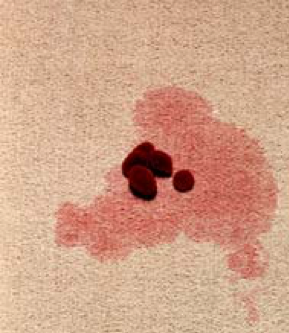
Wick-back stain
Pulls and Snags
Pulls and snags are directly related to the level of tuft bind. Traditionally, this is caused by not enough latex on the back or the wrong backing for the application.
Plasticizer Migration
Plasticizer migration happens when there’s major incompatibility between the backing system and the adhesive used. The two chemicals come in contact and form a reaction. The plasticizer mixes with the adhesive and softens it. And again, this incompatibility creates an oily substance that causes the adhesive hold to be eliminated, in addition to unsightly appearance.
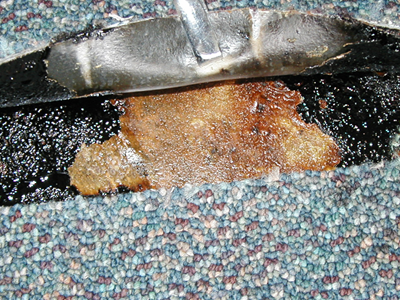
Plasticizer Migration
Seams pulling apart
A typical cause of seams pulling apart is not using enough seam sealer, or the carpet is seamed in a place that must withstand abuse and high traffic. Seams might also pull apart if the wrong backing is used.
Poor Pattern Match
Poor pattern match is another problem you may run into with carpet. This is bow, skew or pattern elongation. Pattern bow and skew is when the pattern is distorted across the width of the carpet. When it sags in the center, that is described as bowing. When the pattern is out of square with portions of the tufted pattern and deviates from a straight line, that is described as pattern skew.
Pattern elongation describes when the pattern size may vary in length or width from one match to the other. The pattern appears as if it is growing along one side of the seam and shrinking on the other. This typically happens during the backing process when the carpet is pulled through the backing line.
Carpet Backing Warranties and Standing The Test of Time
Backing selection can be complicated; however, once you are able to determine the highest priority issues for your particular installation, reviewing test results and the warranties for the various products you may be comparing may help in your selection.
Here are a few steps to follow in finding the product and the warranty that meets your needs:
1. Determine your highest priority performance issues as they relate to backing.
2. Examine the various warranties that manufacturers offer.
3. Select a backing system that provides warranties that best suit the market segment end use.
4. Keep documentation for your customers should they ever need to call on the warranty provisions.
While pattern, fiber and color often catch the attention of carpet specifiers, what is on the underside of the carpet can play just as important of a role in the overall success of your project. Make sure to consider the specific needs of your end use application as well as the test results and warranties of the different backing options before making a final selection.
Related: 3 Common Commercial Carpet Backing Types
Ready to test your knowledge on commercial carpet backing systems? Your local sales representative would be happy to present an accredited CEU on this topic. You can also download the eBook below for more information about carpet backing options.

